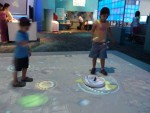Entities that Utilize the Theory of Multiple Intelligences in a Thorough and Beneficial Way
MULTIPLE INTELLIGENCES AROUND THE WORLD
Multiple intelligences (MI) theory has been introduced and implemented successfully in numerous countries around the world. Multiple Intelligences Around the World is the first book to review, synthesize, and reflect on this unique cross-cultural and educational phenomenon. Through this synthesis and reflection, the book’s authors provide a fresh and fuller understanding of MI theory. In addition, they develop more specific knowledge about why MI theory has been welcomed in so many countries, how its use can be appropriate in diverse cultures, and what has supported and fueled travel of the MI meme.
Multiple Intelligences Around the World Amazon Page
PROJECT SPECTRUM
Project Spectrum is a collaborative research project from Harvard Project Zero. Project Spectrum sought to offer an alternative approach to assessment and curriculum development for the preschool and early primary years. Project Spectrum’s work is based on the belief that each child exhibits a distinctive profile of different abilities, or spectrum of intelligences. These intelligences are not fixed; rather, they can be enhanced by educational opportunities such as an environment rich in stimulating materials and activities. The Spectrum approach emphasizes identifying children’s areas of strength and using this information as the basis for an individualized educational program.
Project Spectrum Website
Project Spectrum Materials
EXPLORAMA
Explorama, which is based on Howard Gardner’s theory of multiple intelligences, is an interactive park which teaches about the different learning techniques of different individuals. In Explorama, there are 50 activities that invite you to play around with the concepts of creativity and intelligence. The house is divided by Howard Gardner’s eight intelligences. Each intelligence area contains 4-5 activities. Every human being is equipped with multiple intelligences. But we are stronger in some than we are in others. This means that the ways the different intelligences are combined are as varied as the individual human faces and personalities.
SCRATCH
Scratch, developed by the Lifelong Kindergarten Group at the MIT Media Lab, is a youth-oriented programming language that makes it easy to create your own interactive stories, animations, music, and art. Moreover, students are easily able to share their creations on the web. As young people create and share Scratch projects, they develop important mathematical and computational skills, while also learning to think creatively, reason systematically, and work collaboratively. In turn, Scratch calls upon, and strengthens, the various intelligences of MI theory.
SMALLAB LEARNING
SMALLab, the Situated Multimedia Arts Learning Lab, is an embodied learning environment. Motion-capture technology tracks students’ 3D movements as they learn in an immersive, interactive space. For example, as students are learning about a physics concept like velocity, they can hear the sound of their actions getting faster. They can see graphs and equations that represent their motions in real time. They can feel the weight of an object in their hand as they interact in real physical space. This technology, developed by researches at Arizona State University, is an exemplary model of how the pluralization of learning embodies MI theory.
MAKEY MAKEY
MaKey MaKey is a kit for inventors of all ages based on research from MIT Media Lab’s Lifelong Kindergarten. This interactive kit allows participants to create their own projects and activities; everything from playing Mario Kart with Play-Doh to playing piano on bananas. The kit connects conductive materials to a computer program, allowing autonomous exploration and discovery. The very nature of MaKey MaKey allows students, of all ages, to self-discover their multiple intelligences.






